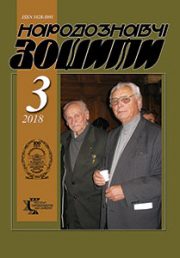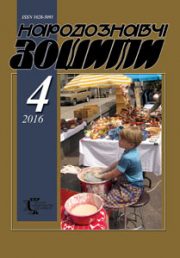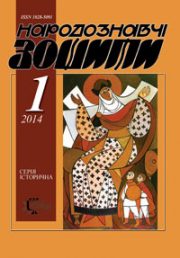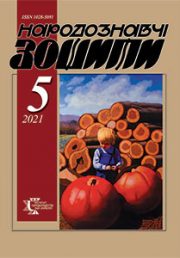The Ethnology Notebooks. 2018, 6 (144), 1505–1527
UDK 655.533(477)»1917/1919»
DOI https://doi.org/10.15407/nz2018.06.1505
Received 21.11.2018
«UKRAINIAN ALPHABET» OF HEORHIJ NARBUT
ORCID ID: https://orcid.org/0000-0003-0580-684X
Filevych Markiyan, curator,
“IconArt” Gallery,
26 Virmenska Str., 79008, Lviv, Ukraine.
Contacts: mfilevych@gmail.com
Abstract. The series of illustrations under the name «Ukrainian Alphabet» belongs to the notable art pieces of graphic artist Heorhij Narbut. Despite the vast research of the art of Narbut, the series was not researched as the separate art piece. Usually it was presented in the context of other art works by Heorhij Narbut. There was lack of the deep analysis of each illustration.The article presents the circumstances and history of creation, first exhibitions and further fate of the «Ukrainian Alphabet» on the basis of numerous memoirs and documents. Furthermore the article presents iconographical analysis of each illustration of the series: their plausible visual and literature sources of influence as well as the hidden meanings and interpretations. The analysis of illustrations conveys the idea that Narbut had used predominantly visual sources for his inspiration. For this purpose he used his previous works as well as the works of his colleagues from the artistic circles in St. Petersburg. In certain cases the iconography of illustration may be might be followed until the Ukrainian baroque illustration of 18th century. The research allows to understand the «Ukrainian Alphabet» not only in the context of Narbut art, but also in the general context of art at the time of its creation.
Keywords: Heorghij Narbut, book graphic arts of the early 20th centrury, illustration, «Ukrainian alphabet», «Mir iskusstva».
REFERENCES
Balits’kyj, P. (1926). Memoirs about Narbut. Bibliolohichni visti. 3 (12), 52—57 [in Ukrainian].
Bezkhutryj, М. (1973). Heorhij Narbut in the collection of Kharkiv Art Museum. Kharkiv: Art Museum [in Ukrainian].
Beletskyj, P.I. (1985). Heorhij Narbut. Leningrad: Iskusstvo [in Russian].
Benois, А.N. (1980). Memoirs (Vol. 1). Moscow: Nauka [in Russian].
Bertall. (1861). ABC. Trim, alphabet enchantй. Paris: L. Hachette [in French].
Bilets’kyj, P.O. (1958). Heorhij Narbut. Essay on life and work. Kyiv: Derzhavne vydavnytstvo obrazotvorchoho mystetstva i muzychnoi literatury URSR [in Ukrainian].
Bilets’kyj, P.O. (1983). Heorhij Narbut. Kyiv: Mystetstvo [in Ukrainian].
Bilokin’ S. (1998). On the pages of the lost «Diarium». Pam’iatky Ukrainy, 30—35 [in Ukrainian].
Bilokin’, S. (2010). Chronicle of life and art of Heorhij Narbut. Siverschyna v istorii Ukrainy. 3, 263–281 [in Ukrainian].
Burachek, М. (1927). Memoirs about Heorhij Narbut. Bibliolohichni visti, 1 (14), 91—101 [in Ukrainian].
Bialosynskaia, N., Panchenko, N. (1990). Oblique rain. In V. Narbut, Poems (pp. 5–44). Moscow: Sovremennik [in Russian].
Chekhonyn, С. (1923). Memoirs about H.I. Narbut. Arhonavty, 1, 22–26 [in Russian].
Chyzhov, А. (2014). Alphabet of H.I. Narbut. Histrory of creation and specialities of artistic style. Vestnik Moskovskogo gosudarstvennogo universiteta pechati, 3, 123–131 [in Russian].
Dobuzhyns’kyj, М. (1987). Memoirs. Moscow: Nauka [in Russian].
Dombrovskyj, А. (2010). Chekhonin. Proektor, 3, 38–39 [in Russian].
Ernst, F. (1925). Posthumous exhibition of works by H.I. Narbut. Bibliolohichni visti, 1—2, 180–181 [in Ukrainian].
Ernst, F. (1926). Heorhij Narbut and new Ukrainian book. Bibliolohichni visti, 3, 5—35 [in Ukrainian].
Ernst, F. (1926). Heorhij Narbut. Life and work. In F. Ernst (Ed.). Posthumous exhibition of works (pp. 11–88). Kyiv: State Press of Ukraine [in Ukrainian].
Zerov, M. (1927). My encounters with H.I. Narbut. Bibliolohichni visti, 1 (14), 102–105 [in Ukrainian].
Karmazyn-Kakovs’kyj,W. (1982). Yurij Narbut. Notatky z mystetstva, 22, 29–34 [in Ukrainian].
Kovalevs’ka, О. (2015). Portraits of Petro Doroshenko: problems of detection, research and usage. Petro Doroshenko and his epoche in Ukraine (Proceedings of Ukrainian Scientific Conference dedicated to 350 anniversary of the beginning of Petro Doroshenko government) 21–29, Nizhyn [in Ukrainian].
Kuzmin, M. (1923). H. Narbut (In occasion of the posthumous exhibition). Russkoe iskusstvo, 1, 35 [in Russian].
Lahutenko, О. (2007). Essays on the history of Ukrainian graphic art of 20th centutry. Kyiv: Grani-T [in Ukrainian].
Mytrokhyn, D. (1923). About Narbut. Argonavty, 1, 19–21 [in Russian].
Mykhajliv, Y. (1926). Fragments of memoirs about H.I. Narbut. Bibliolohichni visti, 3, 46–51 [in Ukrainian].
Modzalevs’kyj, V. (1998). Grabuzdovs. Pam’iatky Ukrainy, 1, 36–39 [in Ukrainian].
Narbut, H. (1977). Autobiographical notes. Iskusstvo, 2, 67 [in Russian].
Neradovskyj, P. (1922). Catalog of the exhibition of works by G.I. Narbut. Petrograd: Komitet populiarizatsiy khudozhestvennykh izdanij pri rosijskoj akademii istorii material’noj kul’tury [in Russian].
Sichyns’kyj, V. (1943). Yurij Narbut, 1886–1920. Krakow-Lviv, Ukrains’ke Vydavnytstvo [in Ukrainian].
Taranushenko, S. (1927). Remembrance about H. Narbut. Bibliolohichni visti, 1 (14), 106–107 [in Ukrainian].
Taranushenko, S. (2016). Motives of old Ukrainian art in works of Narbut, Studii mystetstvoznavchi, 2, 88–106 [in Ukrainian].
Scherbakivs’kyj, V. (1913). Wood building and carving on wood, vol. 1. Kyiv-Lviv [in Ukrainian].







